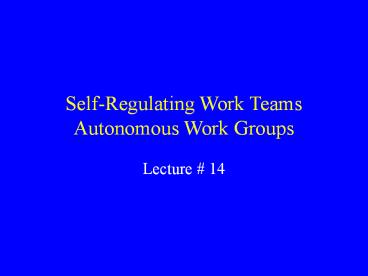Self-Regulating Work Teams Autonomous Work Groups - PowerPoint PPT Presentation
Title:
Self-Regulating Work Teams Autonomous Work Groups
Description:
Self-Regulating Work Teams Autonomous Work Groups Lecture # 14 Self-Regulating Work Teams Self-Managed Teams Self-Regulating Work Groups Autonomous Work Groups Work ... – PowerPoint PPT presentation
Number of Views:236
Avg rating:3.0/5.0
Title: Self-Regulating Work Teams Autonomous Work Groups
1
Self-Regulating Work TeamsAutonomous Work Groups
- Lecture 14
2
Self-Regulating Work Teams
- Self-Managed Teams
- Self-Regulating Work Groups
- Autonomous Work Groups
- Work Teams
3
Team
4
Changes due to Teams
- Teams take on traditional management functions
- Planning
- Organizing
- Directing
- Controlling
5
Changes due to Teams
- Supervisors take on new roles
- Coaches
- Facilitators
6
Coach
- Helping employees to
- work up to their potential
- Learning from athletic
- coaches
7
Facilitator
- Help the group work better as a group
- Help group members
- with process skills
8
For Teams to be Successful
- Task differentiation
- The extent to which the task of the group is
autonomous and forms a relatively self-completing
whole. - -- Cummings Huse
9
(No Transcript)
10
For Teams to be Successful
- Boundary Control
- The extent to which employees can influence
transactions with their task environment. - -- Cummings Huse
11
For Teams to be Successful
- Task Control
- The degree to which employees can regulate their
own behavior in producing the product or
providing the service. - -- Cummings Huse
12
High Involvement Plant (HIP)
13
High Involvement Plants (HIP)
- HIPs are designed around the ideas of task
differentiation, boundary control, and task
control. - Other critical characteristics of HIPs include
14
Organization Structure
- Flat
- Team Based
15
Information System
- Open
- Springfield Remanufacturing Company opens books
to employees, and trains them to understand the
companys finances.
16
Training
- Conducted by Peers (for tasks)
- Interpersonal Skills
- Taught by supervisors or staff
17
Reward System
- Open
- Skill Based
- Gain Sharing (more comprehensive than profit
sharing)
18
Selection
- Realistic Job Preview
- Team Based
19
Identifying Individual and Group Jobs
20
Social Needs
- Determine whether people are likely to be
satisfied with individual jobs or work groups
21
Growth Needs
- Affect whether people will be satisfied by
traditional work designs or by enriched,
self-regulating forms of work
22
Technical Interdependence
- The extent to which employees must cooperate with
each other in order to produce a product or
provide a service
23
Technical Uncertainty
- The extent to which employees must process
information and make decisions in order to
produce a product or provide a service
24
Technical Interdependence/Uncertainty
Low Interdependence Low Uncertainty Traditional Job High Interdependence Low Uncertainty Traditional Work Group
Low Interdependence High Uncertainty Enriched Job High Interdependence High Uncertainty Self-Managed Team
25
Social Needs / Growth Needs
Low Social Needs Low Growth Needs Traditional Job High Social Needs Low Growth Needs Traditional Work Group
Low Social Needs High Growth Needs Enriched Job High Social Needs High Growth Needs Self-Managed Team
26
Lessons from REAL Teams
- 1995-1996 Chicago Bulls
- 72 Wins 10 Losses
- .878 winning percentage
- Best NBA record ever
27
Lessons from REAL Teams
- Killer Bees, high school team in New York
- 1980 1993 went 164-32
- .836 winning percentage
- State Tournament 6 times
- Final Four 4 times
- State Champs 2 times
28
Lessons from REAL Teams
- School population varied from 41 to 67 total
- Never more than 19 boys
- Team never had more than 7 members
29
Lessons from REAL Teams
- Reading High (Mass.) boys track field
- Hasnt lost a league dual meet in 29 years
- Tied once in a 1973 meet
30
Lessons from REAL Teams
- Both the Killer Bees and the Reading High teams
cross-train. - The members can fill in a variety of tasks.
- What does this say about specialization?































